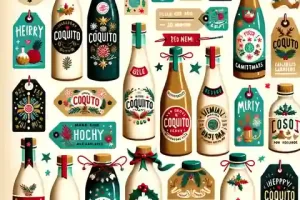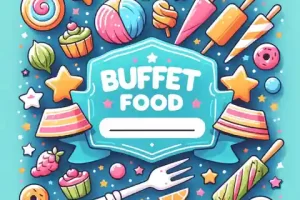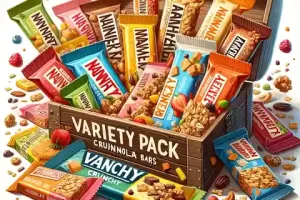A cottage food label template helps people who make and sell food from their homes. It’s like a guide to make sure your food labels have all the right information.
Creating a label for your cottage food products is an essential step in marketing and legally selling your homemade goods.
Below is a detailed guide on what to include in your cottage food labels, based on common requirements across various states.
Cottage Food Labeling Requirements
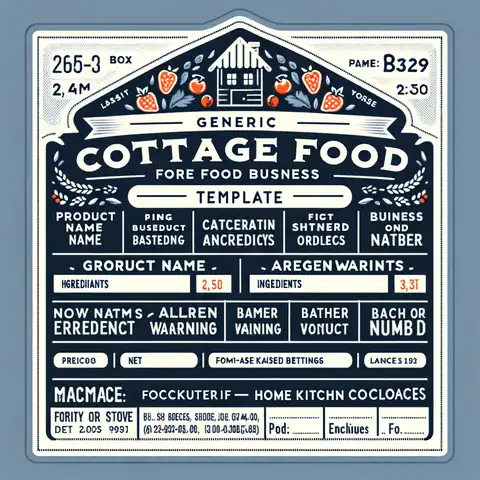
Cottage food labeling is important for those who make and sell food from home. Here’s a simple guide to what you should include on these labels:
- Product Name: Write down what your food is called. Make sure it’s clear and easy to understand.
- Business Name: Put the name of your home food business on the label.
- Business Address: You need to include where your business is located. If you’re worried about privacy, some places let you use a PO Box instead.
- Ingredients: List everything that’s in your food. Start with the biggest ingredient and go down to the smallest. Don’t forget to include spices and flavors.
- Allergens: It’s really important to say if your food has things that some people are allergic to, like nuts, dairy (like milk or cheese), wheat, or soy.
- Net Weight: Write how much your food weighs or how much is in the package. This helps customers know how much they’re buying.
- Contact Information: Sometimes, you need to provide a way for customers to contact you, like a phone number or an email address.
- Home Kitchen Disclosure: Some states ask you to say that your food was made in a home kitchen. You might also need to include a license or permit number.
- Other Information: Depending on where you live and what kind of food you’re selling, you might need to add more details. For example, if you’re selling pickles or something fermented, you might need a special batch number.
How to Make a Cottage Food Label?
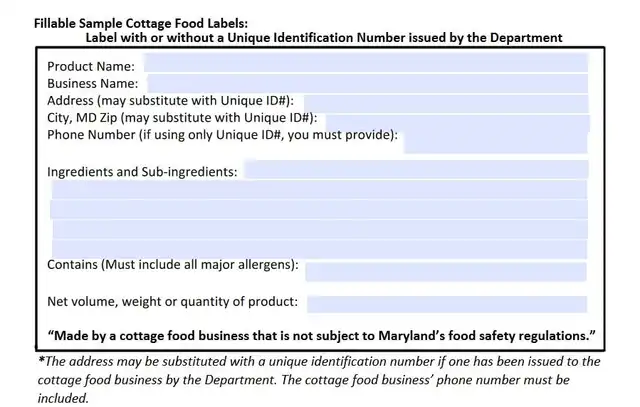
Here’s a detailed look at how to make a cottage food label:
Choose a Label Type
- Consider Your Product: The type of label you choose should suit your product. For instance, if your product is likely to come in contact with moisture (like jams or pickles), a waterproof label might be necessary.
- Types of Labels:
- Stickers: These are easy to use and can adhere to most packaging types.
- Paper Labels: Paper labels can be more cost-effective and offer a rustic look. They can be attached with string or glue but may not be as durable as stickers.
- Special Labels: For unique packaging, you might need custom-shaped or textured labels.
Designing the Label
- Use Design Software: Tools like Canva, Adobe Spark, or even Microsoft Word can be used for designing labels.
- Include Essential Information: As per BakeCalc and other resources, ensure to include the product name, business name and address, ingredients, allergens, net weight, and any required disclaimers.
- Reflect Your Brand: The design should represent your brand’s aesthetic. Include your logo, brand colors, and any other elements that make your label stand out.
- Ensure Readability: Important information should be easily readable. Choose fonts and colors that are clear and legible.
Printing the Label
- Home Printing: If you have a quality printer, you can print labels at home. Ensure you use the right type of paper or sticker sheets for your printer.
- Professional Printing Services: For higher quality, consider professional printing services.
- Label Printers: Some cottage food producers use label printers like Munbyn, as mentioned by Better Baker Club.
Compliance and Regulations
- Check Local Regulations: Make sure your label meets all the necessary legal requirements for cottage foods in your state or locality. This may include specific statements, font sizes, or allergen listings as detailed on sites like PickYourOwn.org.
- Update as Needed: Regulations can change, so it’s important to stay informed and update your labels as necessary.
Additional Tips
- Experiment with Designs: Don’t be afraid to try different layouts and designs. Test a few options to see what looks best on your product.
- Feedback: Get feedback on your labels from friends, family, or customers. They can provide valuable insights into what works and what doesn’t
Cottage Food label template
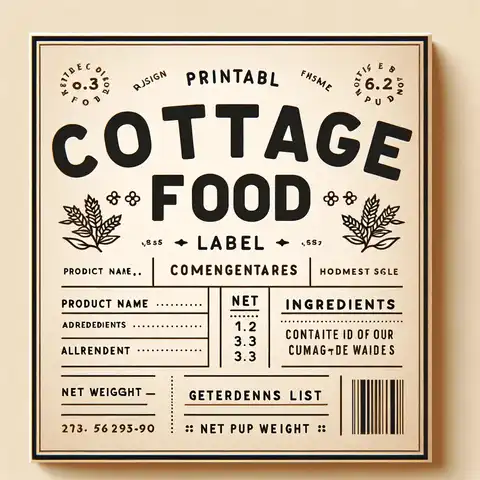
Creating a label for cottage food is really important for people who make and sell food at home. The rules for these labels can be different depending on the state you’re in. Here’s a simple explanation of what you might need to put on these labels in different places:
Write the name of your food. List what’s in it, starting with the most used things. Put your business name and where you are. Tell if there are things like nuts or milk. And say how much food is in the package.
Each state has its own rules, so it’s important to check what your state needs.
Printable Cottage Food label template
you can find free labels to print. You can change them to be perfect for your food.

Florida Cottage Food label template
In Florida, put your business name and where you are. List what’s in your food, starting with the most. Say how much your food weighs. Tell about any allergens. And say that the state didn’t check your food for safety.
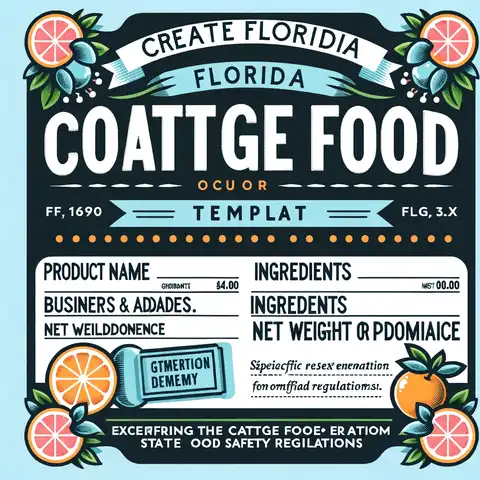
California Cottage Food label template
In California, write the name of your food and your business name and address. Say it was made in your home kitchen. List the ingredients and how much there is.
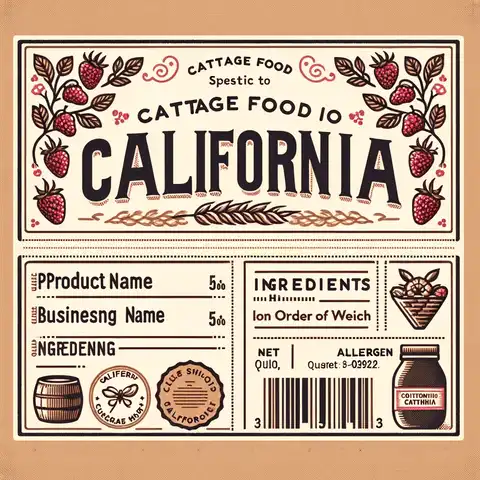
Ohio Cottage Food label template
In Ohio, you need the food’s name, how much there is, what’s in it, your business name and address, and say it was made at home.
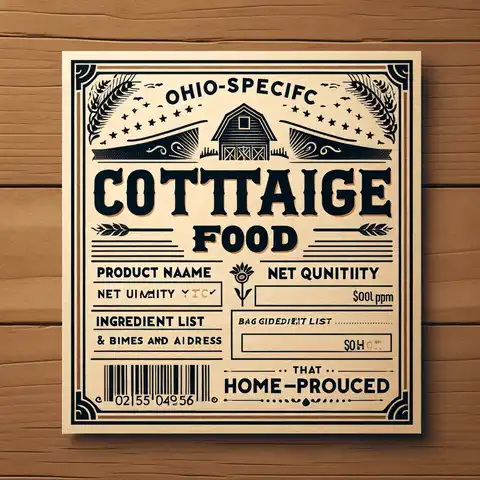
Cottage Food Label Example
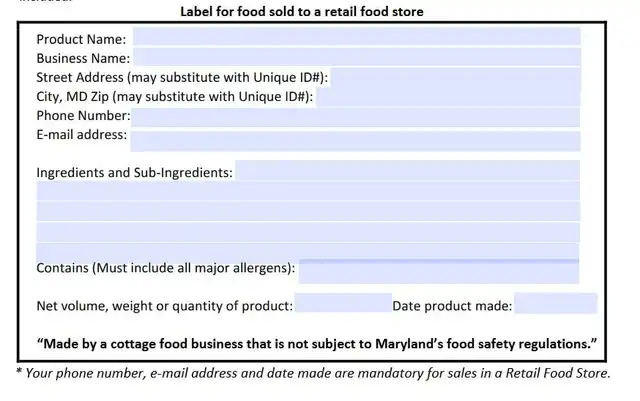
Here’s an example of what a cottage food label might look like:
- Product Name: The name of the food product, like “Homemade Strawberry Jam.”
- Business Name and Address: The name of your cottage food operation and the physical or mailing address.
- Ingredient List: Ingredients should be listed in descending order of predominance by weight. For example, “Ingredients: Strawberries, Sugar, Pectin, Lemon Juice.”
- Allergen Statement: If applicable, list any allergens present in the product. For instance, “Contains: Nuts” or “Produced in a facility that also processes wheat.”
- Net Weight or Volume: The amount of the product, such as “Net Wt. 8 oz (227 g).”
- Statement of Responsibility: This includes the name and address of the cottage food producer.
- Statement of Non-Inspection: A disclaimer stating that the product was made in a home kitchen not inspected by the state or local health departments, such as “This product is home-produced and not subject to state inspection.”
Conclusion
Cottage food labels are more than just a legal requirement; they are your product’s calling card. Ensure that your labels are thorough, accurate, and memorable.
Resources
For more detailed information and state-specific requirements, you can visit websites like Better Baker Club, BakeCalc, and Stomp Stickers, which offer comprehensive guides and resources on cottage food labeling.
FAQs
Can I design my cottage food labels any way I want?
You can make them look nice, but they must include things like what’s in your food, warnings for allergies, and your business details. Make sure everything is easy to read!
Do I need different labels for different kinds of food?
Yes, every kind of food you sell needs its own label. The label should tell what’s in the food, how much it weighs, and other important stuff.
How do I know if my labels are okay by the rules? A: To make sure your labels are right, look at your state’s rules about cottage food. Websites like BakeCalc and PickYourOwn.org have lots of information.
Where can I print my food labels?
You can print them at home if you have a good printer. Or, you can use a professional service, especially if you need special labels that don’t get ruined by water.
Can I put nutrition information on my labels?
A: You don’t have to put nutrition info unless you’re saying your food is extra healthy. If you do put it, make sure it’s right and follows the rules.
Can I find templates for food labels online?
Yes! There are lots of free and some you can pay for. You can change them to fit what you need for your food and the rules in your state.
Is it okay to write my labels by hand?
A: You can write them by hand, but make sure it’s clear and has all the important stuff on it. Printed labels usually look more professional.
the rules for labels can be different in each state, so make sure you know what your state says you have to do!
